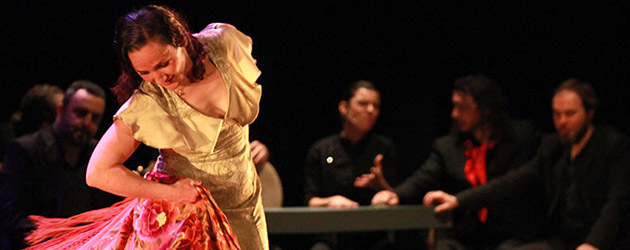Text: Estela Zatania
Photos: Ana Palma
Concha Jareño «El Baúl de los Flamencos»
Claudia Cruz, Marina Valiente «Cádiz, Sevilla ¡Qué maravilla!»
Tuesday, March 3th, 2015. Jerez de la Frontera
19th Festival de Jerez – All the information
Tuesday the Festival de Jerez was marred by another passing in the few days since the event began. Juan de la Plata, writer, flamencologist and founder of the venerable Cátedra de Flamencología de Jerez since 1958 was 83 years old.
But the Festival continues its course, last night with three female dancers at two venues with two shows that were different from the usual offerings.
Women's dance takes over Tuesday at the Festival de Jerez
CONCHA JAREÑO «EL BAÚL DE LOS FLAMENCOS»
Teatro Villamarta, 900pm
Dance: Concha Jareño. Guest artist (dance): Adrián Santana. Special collaboration (guitar): Juan Antonio Suarez «Cano». Guest artist (voice and dance): Ana Salazar. Cante: Manuel Gago, David Sánchez «El Galli». Percussion: Bandolero. Palmas: Torombo. Original idea, artistic director, choreography and repertoire: Concha Jareño. Artistic director, choreography, musical transitions, photography and repertoire: Rafael Estévez. Original music and music director: Juan Antonio Suárez «Cano».
The libretto of the work «El Baúl de los Flamencos» of Concha Jareño is complicated. There are a dozen scenes for over a dozen cantes, some as exotic as the «calesera» or the «soleá petenera». It's a sign of prodigious minds at work, such as those of the unstoppable Rafael Estévez and Concha Jareño herself. They have a history of being outstanding, and always deserve attention.
And they investigate. In this case, the idea was to highlight the various accessories of flamenco dance, and reveal something about their origins. The shawl, the fan, castanets, cane, finger cymbals, the cape, the Spanish hat and the dress with long train, each element had its moment. The idea is good, if only to help guarantee the continuance of these items in flamenco dance; for years they were considered corny unnecessary gimmicks, but are enjoying a comeback thanks to the effort of certain dancers who have continued to use them.
Concha is a flamenco and Spanish dancer with a good level of preparation. She came to Jerez with a high-quality artistic team and a well-prepared show. Although it gets complicated at times; there were moments when it was hard to follow, and I found myself wishing they would just dance and sing without so much conceptual baggage.
No problem however with the actual dances. This is a very varied and entertaining historical survey. According to the program: bulerías, zapateado, tango de Cádiz in the version of Mochuelo and another inspired by Pastoria Imperio, calesera and trilla, guajiras, martinete with jotilla, taranto and verdial, pregón and cantiñas, caracoles, zapateado y caña, pasodoble and caña, soleá petenera and peteneras…it makes my head spin just thinking of what today's singers are expected to deal with. And good singers were on hand doing a great job. David «El Galli» has turned into a solid professional, and Wednesday we'll have the chance to hear his acoustic recital at the Palacio Villavicencio.
Concha is beautiful dressed in the old style for guajiras with fan and a short-trained dress. Dancer Adrián Santana does a fine job with a variety of dances and roles, and dancer-singer Ana Salazar is delightful in her androgynous multi-purpose part. The music for this complex work was supplied by the admirable guitarist Juan Antonio Suárez «Cano».
CLAUDIA CRUZ, MARINA VALIENTE «CÁDIZ, SEVILLA ¡QUÉ MARAVILLA!».
Sala Compañía, 700pm
Dance: Claudia Cruz, Marina Valiente. Cante: Pepe de Pura. Guitar: Román Vicenti. Choreography: Claudia Cruz, Marina Valiente. Alegrías choreography: Manuel Liñán.
At seven in the evening, at the Sala Compañía, we were able to see two young women dancers, Claudia Cruz and Marina Valiente, from Cádiz and Seville respectively.
The concept of a flamenco dance duo went out of style some time ago, and as far as women, you see it even less. But this is an area worthy of attention, and these two dancers develop it with intelligence and creativity. The first scene included two solo dances by Claudia and Marina, a taranto and a zambra that was half-way between Granada and Caracol, with brightly colored clothing, and hip movement straight out of oriental dance. There is also soleá por bulería and siguiriyas, but without a doubt the alegrías cantiñas of the two together dressed in white batas de cola is what has the greatest impact and shows the tremendous discipline of these women. Something different from the usual that shows not everything has to be black and darkness in order to be flamenco.
